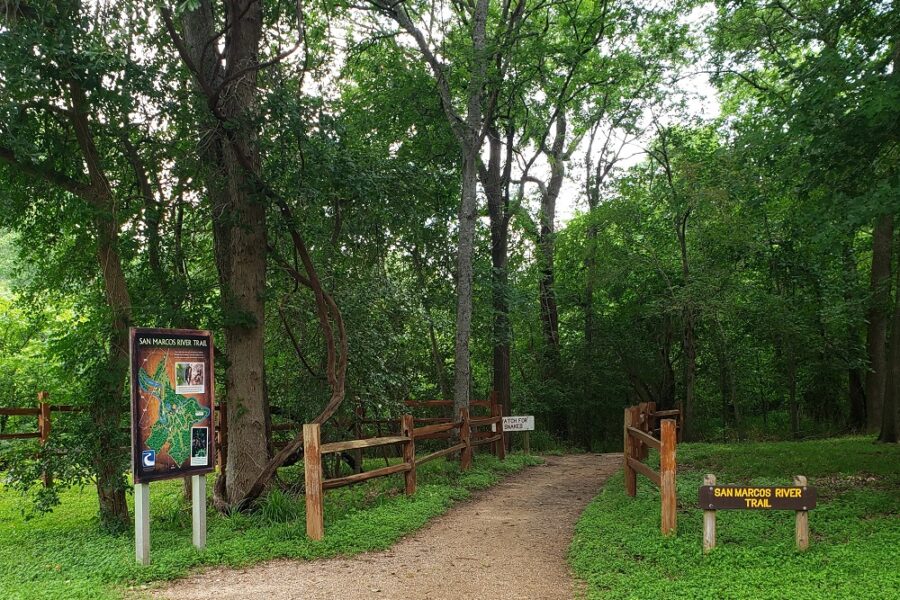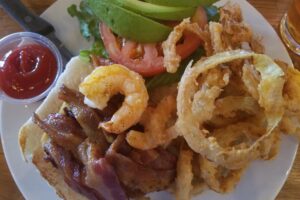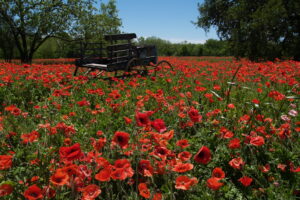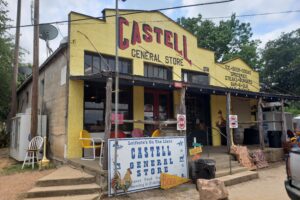Opening my eyes, I see darkness. I look to my left and try to focus on the clock across the room—6:15 am. I don’t smell coffee. I do smell bacon and hear clunking and clattering and sizzling sounds. By the time I wander into the kitchen thirty minutes later, Michael is in the throes of finishing a mayonnaise-less potato salad for today’s picnic at Palmetto State Park. I glance at his recipe. Red potatoes, sour cream, bacon, ranch dressing, cheddar cheese, green onions—it sounds very much like the baked potato of my dreams. Michael smoked a chicken yesterday, and I see celery sticks in a container. I think I like it when it is his week to plan on how to feed us.
Getting There
At 9 am, we are in the car racing south on RR 12 heading for Luling. The early morning fog still hangs low overhead, caressing the Texas hills and softly kissing the crowns of the tallest trees, leaving the road free of the ephemeral mist. With the fog and the haze behind us, Michael turns left working his way down narrow lanes with names like Old Bastrop and Staples and Scull that take us into Martindale and onto Highway 80.
It makes my heart glad when we pass by Taco Feliz—my introduction to food truck dining when we first moved to Wimberley over a decade ago—and I see a short line of customers waiting for their breakfast tacos.
Palmetto State Park

We drive through Luling, turning onto Hwy 183, continuing a few miles when we see a sign for Palmetto State Park at the junction of Country Road 261. It amazes me how much is at our fingertips living in Wimberley; this park is barely an hour away from our doorstep.
I feel like we are in the land of my grandmother’s farm—it all seems so much like deja vu. We stop at a scenic overlook and inhale a pastoral paradise. Cows graze in green fields far below where I stand, and the familiar sound of unseen turkeys whisper memories of childhood during summers on the farm. I think this will be a good day.

Stopping at the park headquarters, we pick up our reservation tag from a bulletin board on the porch of a building built by the CCC in the early 1930’s. I return to the car, and before I can take my place in the passenger seat, I am back on the porch searching for a park map. Compared to the last two parks we have visited, this one is tiny, barely 270 acres. The trail map on my lap tells me that the eight trails available for hiking are easy to moderate in difficulty, and the longest is only 1.25 miles long. I think this is my kind of park.
The Refectory

Since it is too early for lunch, we explore the area from our car, the convertible top down. We stop at its heart in front of a building known as The Refectory, originally built for concessions by seventy-four “CCC Boys” in 1935. Michael sits behind the wheel as I leave the car and read the sign in front of the old stone building. I love what it says, “This building represents a nation’s hope…”
The rest of the story-board tells of the Civilian Conservation Corps, the young boys who built the park, why they were, who they were, and what it was like to be a part of the corps. In the right-hand corner is a reminder that The Vision Continues, and “by enjoying this state park, I am fulfilling FDR’s vision of improved life through recreation.” These pictures and the words that accompany them, make the young men who built this park very real to me—I am glad I stopped to read their story.
The San Marcos River Trail

We scope out the picnic area, discovering we are in the middle of the park’s various trailheads. Michael tells me to choose one. The San Marcos River Trail sounds good, till I see a sign that says WATCH FOR SNAKES, and I look at my bare toes, peeking out from my river sandals. I discovered too late that my tennis shoes somehow managed to walk from the trunk of my car last week to the shoe rack in the garage. I open my eyes wide, look ahead at the path before me, and put one foot forward.



At one and a quarter miles in length, we are on the single longest trail in the park, and if we walk with purpose, we may find ourselves at the end too soon. So, we saunter slowly down the wide level path. Beside and below me, the San Marcos River—heavy with mud from torrential rains earlier this week and overflowing its banks—twists and turns its way south where it joins the Guadalupe River, finally feeding into the waters along the Texas Intracoastal Waterway.

Flora & Fauna



The trail brings more wonders and more questions about flora and fauna than I thought possible. Just a few miles behind us is rural farmland, and before us is a forest filled with trees, many I have never seen before. We stop and look at one multi-trunked tree that I think is an aberration until we walk a few feet further, and then a few feet further than that. I look deeper into the shade they provide and see this strange species is everywhere. It seems impossible to believe that there is a type of tree that has multiple trunks, and even more impossible that this many saplings could have raised their heads from the ground so close together and joined at the proverbial hip. It is a conundrum. I wonder if Google will be able to find an answer for me later.




The trail we walk is level and smooth enough for a bicycle to easily traverse its surface. However, the recent rainstorms of Central Texas are very evident in some places along the path. I have no choice but to step in the goopy mud as it oozes over my sandals and invades my toes. If I were on a bike, I’d probably have more than muddy toes. My path needs to be dry. Not slippery.
“This is yukky,” I complain.
Michael assures me there is a shower where we parked our car, and I will be able to rinse my feet. So, I trudge on, still dodging mud where it is possible to skirt its sticky goo. As we walk along the trail, my impressions are many. I feel we wander from the forest to the Amazon Jungle, to the deep south where giant trees are dense with tendrils of wispy moss.

Legends
We pass by a true blackwater pond, once a mud boil. Perhaps some would call it a swamp or a bog. It is beautiful in its mysterious gloom, but I worry about what lies beneath. I envision the sinister slither of snakes or other creatures that live in the swamps with massive jaws that might find I have very tasty toes. Then I remember a legend about a swamp monster or mud man, a bigfoot-like humanoid “swamp thing” that inhabits this area.

Perhaps the disrupted ground that we saw near the river was not made by a small animal or wild pig, but the “Ottine Thing”—a shy, mysterious dark hairy heavy-footed creature that makes grunting noises and throws rocks at visitors. I, of course, don’t believe it. But it does seem kind of cool that Texas may have their own version of the Lockness Monster.

The End of the Trail
Amid all of these giant trees and ponds, and swamps and bogs and rivers and trails, are low growing palmetto palms and inland sea oats. It is a world of green mystery magic and wonder. It is a friendly, comfortable, walkable park to be revisited, alone, or with children. Even though it is tiny, it’s mighty. I tell Michael we will return. In the early mornings of summer or mid-day during spring and fall—even winter. But I think we should avoid visiting after heavy rains.





Along the way, I find a possible answer to my conundrum—a Trumpet Creeper that attaches to tall trees and climbs to a height of 40-feet. Not a native plant, but invasive. Could it be?
Reaching the end of the trail—it took us almost 90 minutes to traverse its length, with all of our starts and stops and inspections and reflections and conversations—I head to the park’s facilities and wash my feet and shoes in their camping area showers. Upon returning to the car, we begin our search for a perfect picnic site.
A Picnic Spot
The sun is out and many of the picnic tables are sitting in its glow. After our sojourn on the densely canopied trail, I am addicted to shade. So, I look toward the appealing CCC built Refectory. Normally for large groups only, with reservations required, I feel we might be safe invading its space today since the governor has stated that individuals should not gather in groups greater than five people.
We roll our picnic tote through the open-air interior and take up a tiny corner at a table on the wide patio which fronts the river. We dive into Michael’s picnic spread, enjoying the food he prepared, the history, the immense stones used to construct this building, and the trees overhead. After lunch, as we sit on the low stone wall overlooking the water far below, we feel a drop then another and another. Then we hear the rain hitting the leaves above—it is a lovely sound. But a sound that tells us it is time to pack-up and turn our toes toward home.


Palmetto State Park
This Texas State Park is a kid’s paradise—or at least an amazing playground. The trails provide effortless walking and contain myriad horticultural and natural wonders. There is easy access to the normally clear San Marcos River where you can swim tube and fish. There is also small Oxbow Lake for swimming and fishing adjacent to a playground for small children and a picnic area.

The park rents two- and three-person kayaks, as well as stand-up paddle boards through Paddle EZ. Life jackets and oars are included. The park also offers daily bike rentals for adults and kids at park headquarters.
Palmetto State park also has some fishing equipment to loan if you need it, and a big bonus is YOU DO NOT NEED a license to fish from shore in a state park.
For more information click on the following link(s).
https://tpwd.texas.gov/state-parks/palmetto
https://paddleez.com/rules-palmetto/









Leave a Reply
Your email is safe with us.